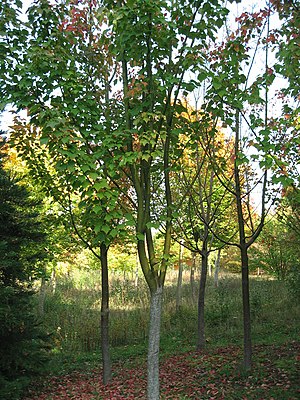Red-nerved snakeskin maple
| Red-nerved snakeskin maple | ||||||||||||
|---|---|---|---|---|---|---|---|---|---|---|---|---|

Red-nerved snakeskin maple ( Acer rufinerve ) |
||||||||||||
| Systematics | ||||||||||||
|
||||||||||||
| Scientific name | ||||||||||||
| Acer rufinerve | ||||||||||||
| Siebold & Zucc. |
The red-nerved snakeskin maple ( Acer rufinerve ) is a species of maple ( Acere ) in the soap tree family (Sapindaceae). The natural range is in Japan .
description
Vegetative characteristics
The red-nerved snakeskin maple often grows as a multi-stemmed, small, deciduous tree and reaches heights of 12 to 15 meters. It forms a regular, narrow, funnel-shaped tree crown . The bark , which remains smooth for a long time, is green to silvery-green, with white longitudinal stripes. The bark of the branches is initially blue and white. The buds are frosted blue and white.
The constantly against arranged on the branches leaves are divided into petiole and leaf blade. The petiole is 2 to 6 inches long. The three-lobed leaf blade is 6 to 15 centimeters wide with a rounded blade base. The side lobes are slightly above the middle. The leaf edge is sharp and unevenly serrated. The upper side of the leaf is dark green and the underside is slightly lighter. Initially the leaf nerves and nerve corners are hairy reddish brown, in summer only the nerve corners are. The leaves turn orange to carmine red in autumn.
Generative characteristics
The flowering time is in May after the leaves have unfolded. The yellow-green flowers are arranged in terminal, rust-red hairy inflorescences . The flowers are unisexual.
The fruit stalks are about 5 millimeters long. The fruits are 2 to 3 centimeters long, initially hairy and later glabrous. The wing is spread at an obtuse angle.
Occurrence
The distribution area is only on the Japanese islands of Honshū , Kyushu and Shikoku .
The red-nerved snakeskin maple grows in cool, moist forests on moderately nutrient-rich, well-drained, fresh to moist, acidic to neutral, sandy-humic or gritty-humic soils in sunny to light-shaded locations. The red-nerved snakeskin maple is usually frost hardy .
Systematics
The species Acer rufinerve belongs to the Macrantha section of the genus Acer . It was first described in 1845 by Philipp Franz von Siebold and Joseph Gerhard Zuccarini in the treatises of the Mathematical-Physical Class of the Royal Bavarian Academy of Sciences. Munich , Vol. 4, 2, p. 155.
use
The red-nerved snakeskin maple is often used as an ornamental plant because of its unusual autumn colors .
proof
literature
- Andreas Roloff, Andreas Bärtels: Flora of the woods. Purpose, properties and use . 3rd, corrected edition. Eugen Ulmer, Stuttgart (Hohenheim) 2008, ISBN 978-3-8001-5614-6 , pp. 80 .
Individual evidence
- ↑ a b c d e f g Andreas Roloff, Andreas Bärtels: Flora of the woods. Purpose, properties and use . 3rd, corrected edition. Eugen Ulmer, Stuttgart (Hohenheim) 2008, ISBN 978-3-8001-5614-6 , pp. 80 .
- ↑ a b c d Acer rufinerve in the Germplasm Resources Information Network (GRIN), USDA , ARS , National Genetic Resources Program. National Germplasm Resources Laboratory, Beltsville, Maryland. Retrieved June 8, 2017.




